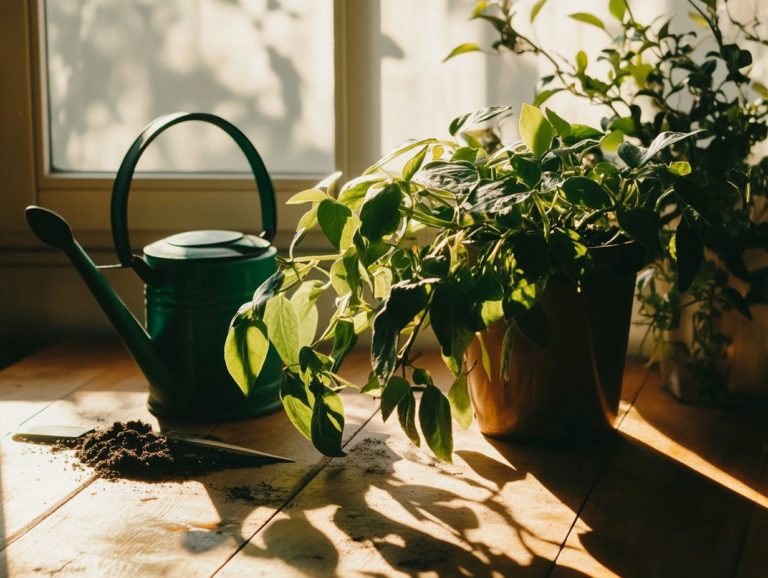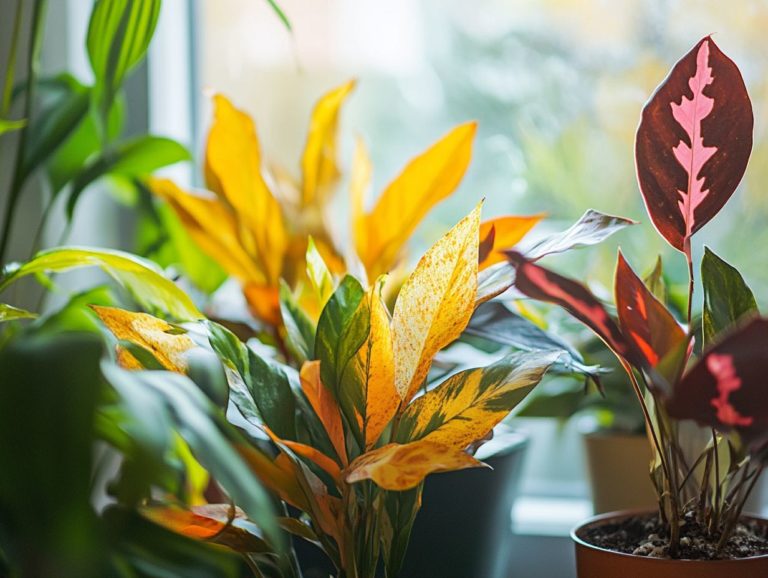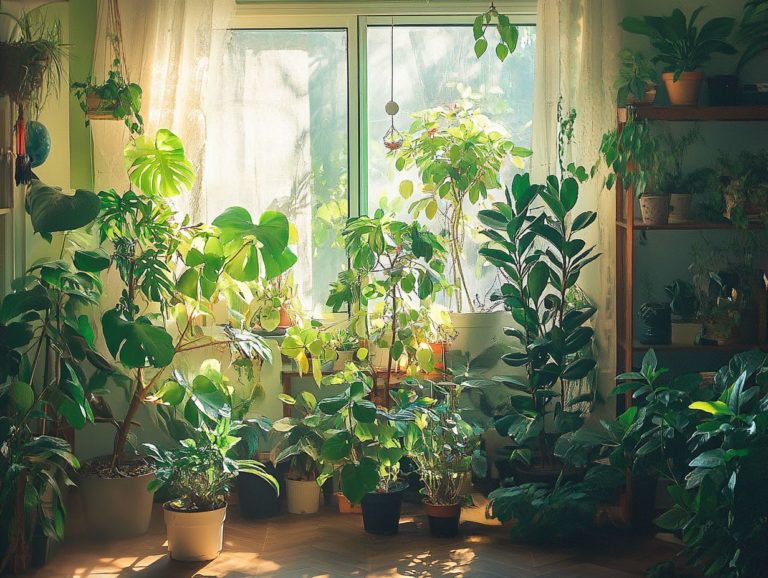How to Restore Health to a Stressed Plant
Plants possess a remarkable resilience, yet they often encounter various stressors that can impede their growth and vitality.
Understanding the common causes of plant stress is essential for any gardener or plant enthusiast. This article delves into how to identify the signs of stress in your hibiscus plants, along with effective strategies for restoring their health and practices to prevent future issues.
It also explores the impact of environmental factors on plant well-being. Discover how to nurture your green companions back to a thriving state!
Contents
- Key Takeaways:
- Understanding Plant Stress
- Signs of a Stressed Plant
- Restoring Health in a Stressed Plant
- Preventing Plant Stress
- Plant Stress and the Environment
- Frequently Asked Questions
- What are some common signs of a stressed plant?
- How do I identify the cause of stress in my plant?
- What is the best way to restore water-stressed plants?
- How can I revive a plant with nutrient deficiencies?
- What are some natural methods for restoring health to a stressed plant, including healthy hibiscus plants?
- When should I consider repotting a stressed plant, especially during summer?
Key Takeaways:
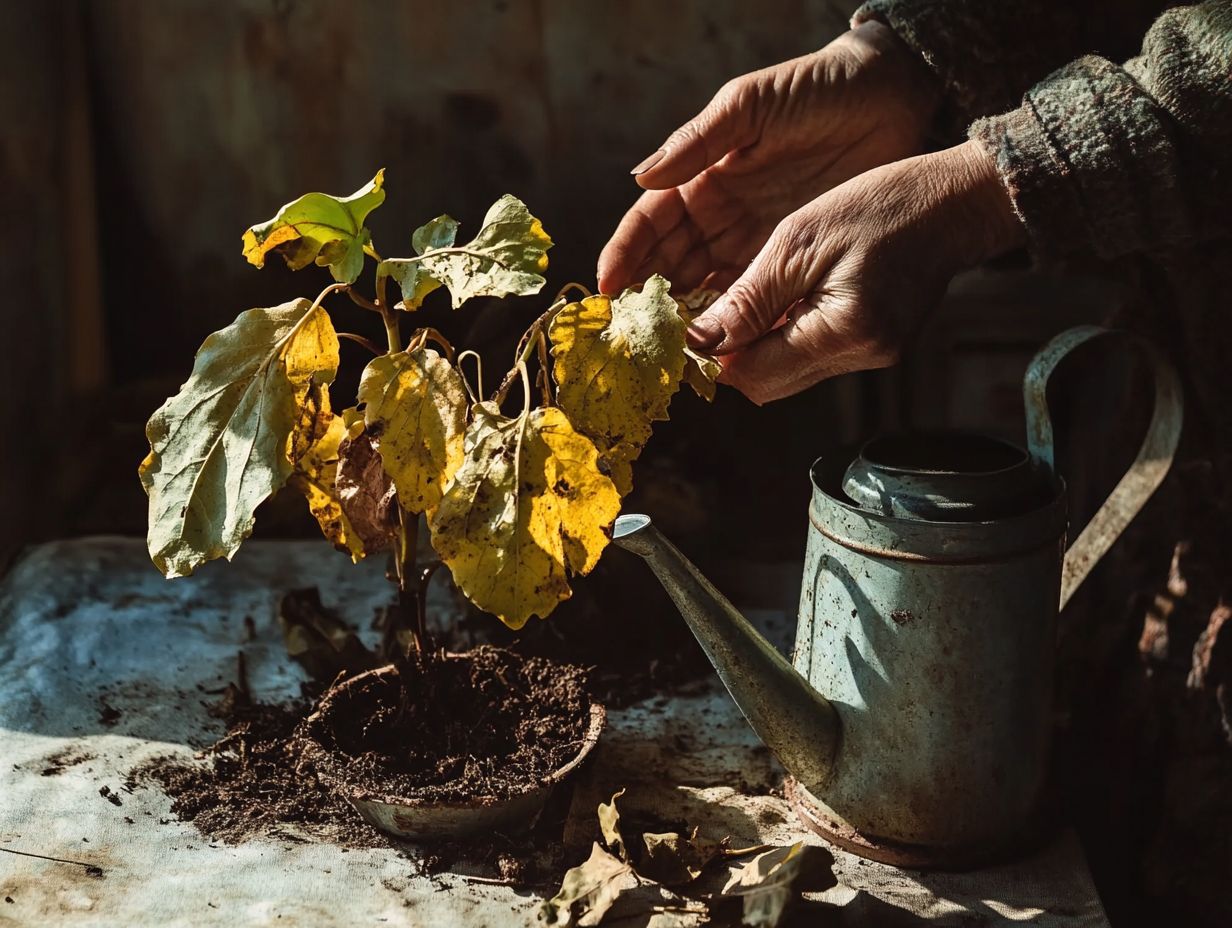
- Identify and address common causes of plant stress, such as inadequate watering, nutrient deficiency, and pest attacks.
- Look for signs of stress in your plants, including wilting, discoloration, and stunted growth, to take prompt restorative action.
- Implement effective techniques and strategies, such as proper watering and fertilization, to restore the health of a stressed plant and prevent future stressors.
Understanding Plant Stress
Understanding plant stress is essential for preserving the vitality of your garden, particularly when caring for sensitive varieties like hibiscus. Factors such as pest infestations, transplanting stress, and extreme heat can significantly affect their growth, resulting in symptoms like yellow leaves and green pigment production that helps plants absorb sunlight.
By identifying these stressors, you can adopt effective care techniques that enable your hibiscus and other houseplants to flourish, even in the face of environmental challenges.
Common Causes of Plant Stress
Common causes of plant stress include environmental factors such as drought, pest infestations, and improper nutrient management, all of which can significantly compromise the health of your plants. Excessive heat amplifies these challenges, leading to wilting or, in the worst-case scenario, plant death if not addressed promptly. When pests invade, they not only drain vital nutrients but may also introduce diseases, creating a vicious cycle of stress.
Inadequate watering practices can leave your plants vulnerable, impacting their overall vigor. You can tackle these issues by using nitrogen fertilizer, which gives your plants the nutrients they need to thrive! Additionally, applying organic mulch helps retain moisture and regulate temperature. This powerful combination not only eases stress but also creates a thriving environment for your plants to bounce back quickly!
Signs of a Stressed Plant
Spotting the signs of a stressed plant is key to giving it the help it needs quickly. Symptoms like yellowing leaves, diminished chlorophyll levels, and drooping stems signal that your hibiscus or other houseplants require immediate attention.
You can assess the effectiveness of your care strategies by closely monitoring their progress over time, ensuring the revival of your beloved green companions.
Identifying Symptoms
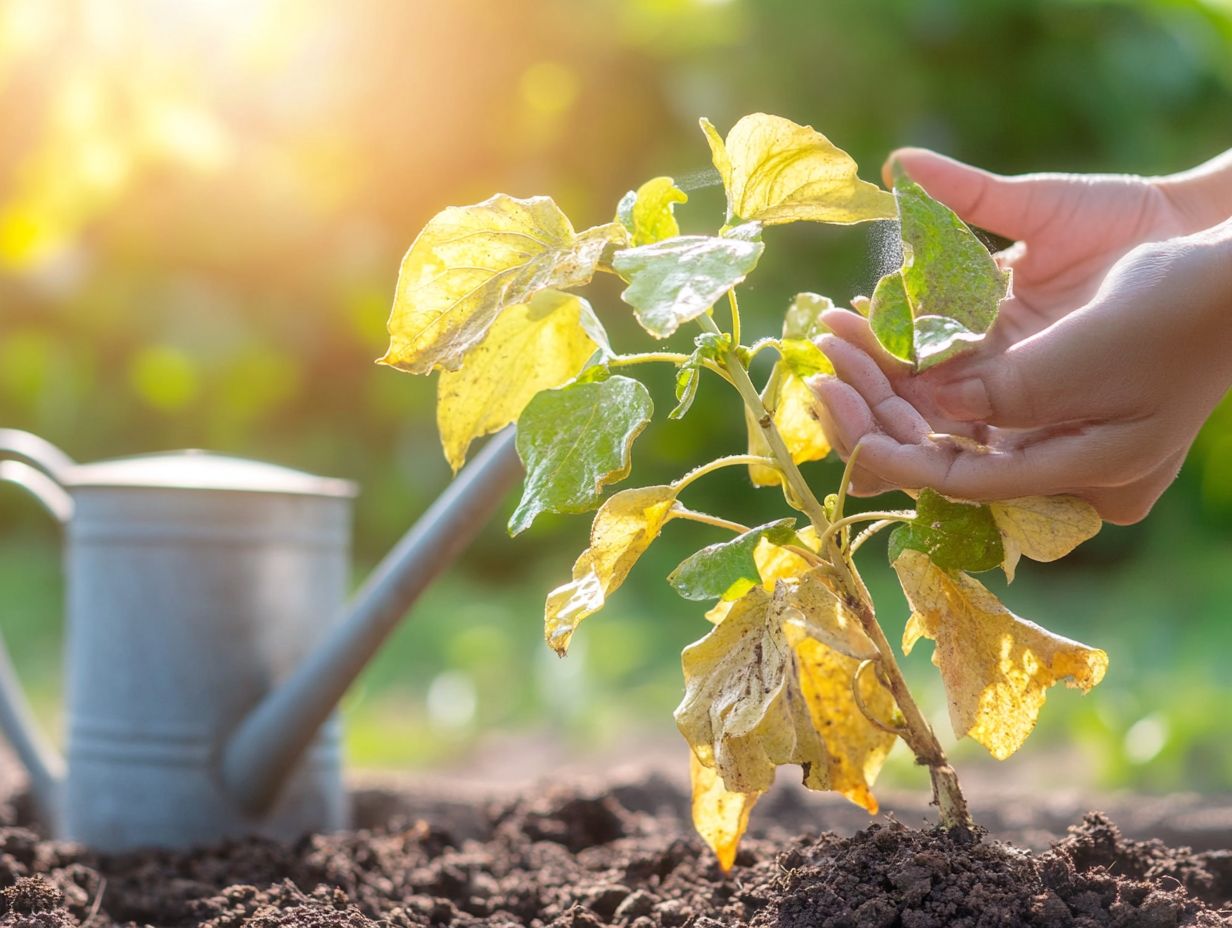
Identifying symptoms of stress in your plants requires a keen eye for physical changes, such as yellowing leaves and wilting, which may point to underlying issues like pest infestations or excessive heat exposure.
You might also notice additional signs like leaf spots or discoloration, indicating potential fungal infections or nutrient deficiencies. Your watering practices play a significant role in how well moisture penetrates the soil, directly impacting root health.
For example, overwatering can lead to root rot, while inconsistent watering schedules may result in soil compaction, making it tough for roots to absorb essential nutrients.
Grasping these symptoms is vital, as it enables you to implement tailored interventions that enhance the overall vitality and resilience of your plants.
In conclusion, understanding and addressing plant stress is crucial for the health of your garden. By recognizing the signs and causes of stress, you can take effective action, such as learning how to revive a wilting houseplant, to help your plants thrive.
Restoring Health in a Stressed Plant
Restoring vitality in a stressed plant requires you to implement specific methods and recovery activities that specifically address its unique stressors, such as nutrient deficiencies or challenging environmental conditions.
For instance, applying nitrogen fertilizer can significantly enhance growth. Organic mulch effectively retains soil moisture and regulates temperature.
You can also use growth enhancers like seaweed tonic or Flower Power to give your plants an extra boost, further revitalizing them and helping them thrive once more.
Effective Techniques and Strategies
Implementing effective techniques and strategies is crucial for revitalizing heat-stressed plants and securing their long-term health. You’ll want to adjust your watering routine to strike a balance, avoiding the pitfalls of over or under-watering.
Utilizing growth hormones, substances that help plants grow faster, can also stimulate recovery, giving your plants a much-needed boost.
Regularly monitoring soil moisture levels will enable you to determine the optimal time to water, allowing for precise care tailored to each plant’s unique needs. It s also wise to provide shade or relocate your plants to cooler spots during peak heat, effectively reducing their stress levels.
Incorporating mulch can work wonders by retaining soil moisture and regulating temperature fluctuations. Additionally, integrating organic fertilizers ensures your plants receive essential nutrients that support vigorous new growth. By focusing on these practices, you can cultivate healthier plants and create a vibrant ecosystem that flourishes throughout the seasons.
Preventing Plant Stress
Preventing plant stress is key to growing vibrant hibiscus and other garden favorites! By adopting proactive measures such as optimizing soil conditions, applying sufficient organic mulch, and carefully assessing sunlight exposure you can greatly diminish the likelihood of stress and the complications that arise from it.
Your efforts will ensure a flourishing garden, brimming with health and vitality.
Practices to Keep Plants Healthy
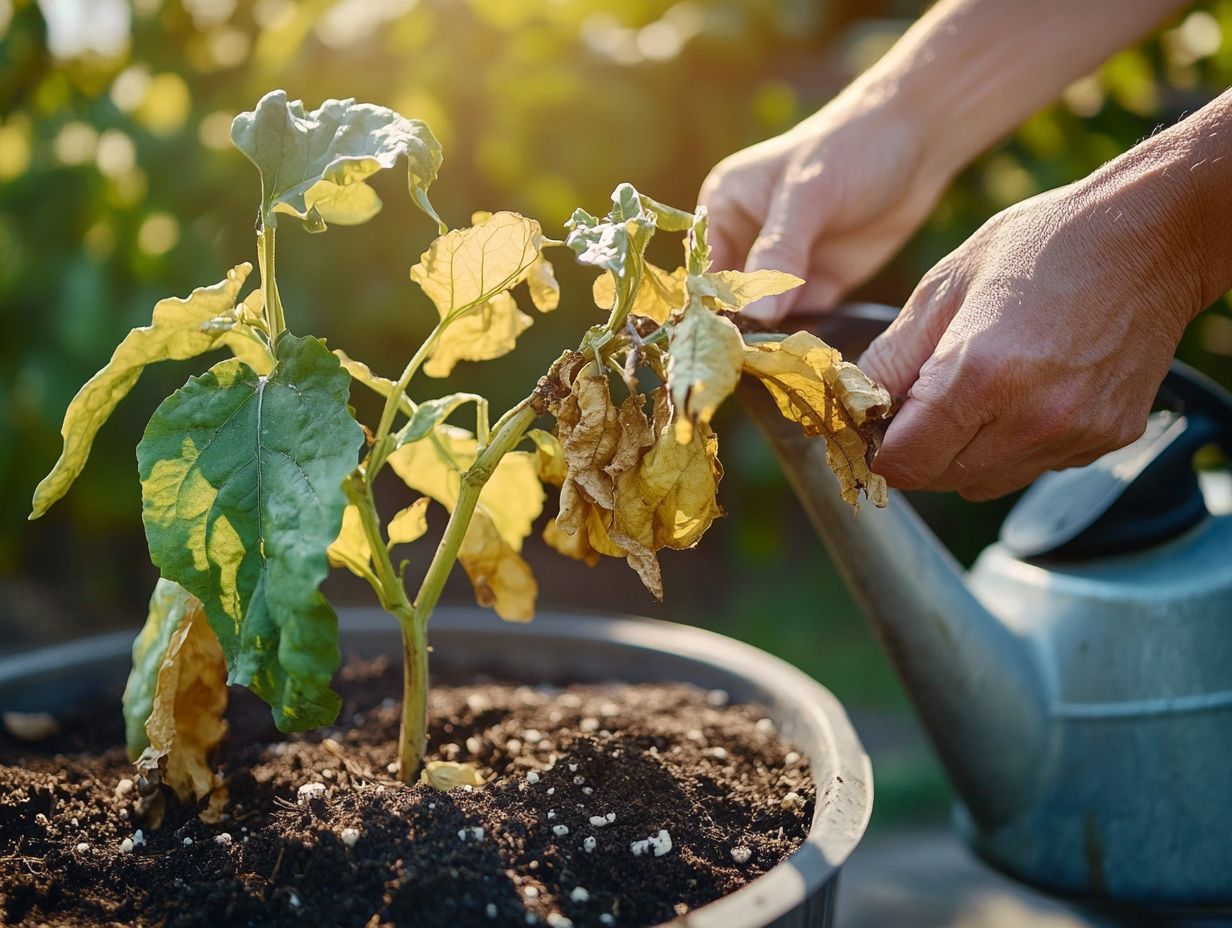
To keep your plants thriving, particularly your healthy hibiscus, establishing a consistent watering routine and incorporating organic mulch are essential practices that significantly enhance their resilience against various stressors.
Beyond these foundational steps, grasping the nuances of nitrogen fertilization can dramatically elevate growth and flowering; nitrogen is a vital nutrient that fosters lush foliage and robust development.
Equally important is effective pest management, as proactive measures can thwart infestations that may weaken or even destroy your plants.
By weaving together these elements regular watering, organic mulch to retain moisture and suppress weeds, and vigilant pest control you can cultivate a flourishing environment where your hibiscus and other plants vibrantly thrive throughout the growing season.
Plant Stress and the Environment
Understanding the intricate relationship between plant stress and environmental factors is essential for your gardening success. Conditions like drought, extreme heat, and pest infestations can greatly affect soil penetration and root systems, triggering a series of stress responses in your plants.
By recognizing these dynamics, you can make informed decisions that promote resilience in your garden.
Impact of Environmental Factors
The influence of environmental factors on plant health is profound. Elements such as heat, pest invasions, and inconsistent watering can induce considerable stress in your plants.
These stressors can upset the delicate equilibrium of soil moisture. This leads your plants to face either drought stress or the perils of drowning in overly saturated soils. Extreme temperatures can worsen these issues, diminishing the beneficial microorganisms essential for soil health and nutrient absorption.
An uptick in invasive pests can dramatically change your plants watering needs. Those afflicted often show signs of wilting due to disrupted water uptake.
Understanding how these factors interact is crucial. This knowledge helps you create effective strategies to boost plant resilience and promote sustainable growth, particularly in challenging conditions.
Frequently Asked Questions
What are some common signs of a stressed plant?

Some common signs of a stressed plant include wilting, yellowing or browning leaves, stunted growth, and dropping leaves or flowers. Keeping an eye on your plants’ health is crucial.
How do I identify the cause of stress in my plant?
The first step in restoring health to a stressed plant is identifying the cause of stress. Check for factors such as over or under-watering, nutrient deficiencies, pest infestations, or environmental stressors like extreme temperatures or lack of sunlight.
What is the best way to restore water-stressed plants?
Is your plant struggling? To restore health to a water-stressed plant, begin by thoroughly watering the soil until water runs out of the drainage holes. If the soil is extremely dry, submerge the pot in a tub of water for a few minutes to allow the soil to fully absorb the water. Repeat this process every few days until the plant shows signs of recovery.
How can I revive a plant with nutrient deficiencies?
If your plant is showing signs of nutrient deficiencies, it may need a nutrient boost. Choose a fertilizer specifically formulated for your type of plant and follow the instructions for application. Be careful not to over-fertilize, as this can also cause stress to the plant.
What are some natural methods for restoring health to a stressed plant, including healthy hibiscus plants?
Avoid using chemical fertilizers or pesticides on stressed plants, as these can further damage the plant. Try using natural remedies like compost, homemade plant fertilizer, or neem oil for pest control. Act now to give your plants the best chance at recovery!
When should I consider repotting a stressed plant, especially during summer?
If the plant’s roots are overcrowded and there is not enough room for proper growth, it may be time to repot the plant. Choose a pot that is slightly larger than the current one and use fresh potting soil to provide the plant with new nutrients and space to grow.

